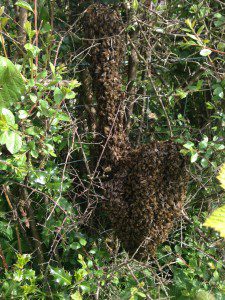
Swarming is a natural process. It is the colony reproducing by the old queen leaving with some of the bees. They leave their hive and find somewhere to hang in a cluster until the scout bees decide on their new home.
Most swarms occur on warm sunny days from May to the end of July usually between 11am – 4pm. A real honey bee swarm can be extremely dramatic involving many thousands of bees in a large noisy cloud However, they normally settle into a cluster within 15 minutes.
If you think you’ve got a swarm please use our Local Association link to find a beekeeper near you.
The beekeeper will ask you questions about the swarm:
- Describe what you have seen or ideally send a picture.
- Size of cluster/how many (e.g. football size etc.)?
- Honey bee swarms are thousands, not a dozen or so
- Location/access (indoors, outdoors, chimney, etc)?
- Height (e.g. 1st floor, roof top)?
- How long have they been there?
- Please inform the beekeeper if the swarm leaves before they arrive or if someone else collects it to save a wasted journey.
Other useful information
Collecting a swarm is normally a two-part process:
- Part one – to get the bees into a box.
- Part two – to return in the evening to remove bees and box.
If on arrival the beekeeper finds that it is not honey bees then they are unlikely to be able to help. Most honey bee swarms are not aggressive but please do keep away and leave them alone. Honey bee swarming is natural and the bees are just looking for a new home.
Bumblebees
Bumblebees are best left alone. They are valuable pollinators, some are endangered. Don’t try to block entrance holes as they will try to find another way out possibly into the property. They will die out naturally in late summer/autumn, therefore the cost of a pest controller is easily avoided. Please don’t use chemicals or other products on them.
Wasps
Wasps may require a pest controller if in a dangerous position. Wasps are also good pollinators and eat pests in your garden. Beekeepers don’t remove wasps.
Important information to note
Swarm collection is carried out by volunteer beekeepers at their own discretion. Swarming bees usually don’t sting but it is wise to stay away from the swarm and keep children & pets indoors.
Beekeepers collect swarms on a voluntary basis; they are NOT paid to provide this service. The beekeeper may not be able to come immediately; they may have jobs and commitments of their own. Beekeepers have to consider their own safety; it may not be possible to remove a swarm from difficult-to-reach places.
